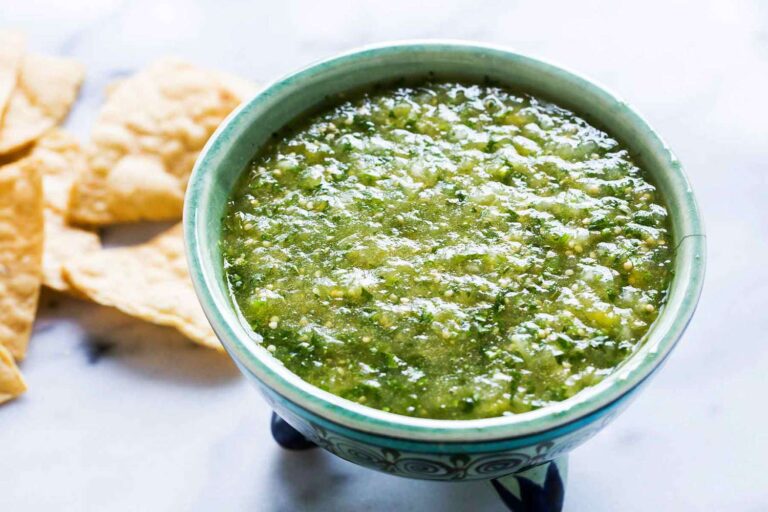Salsa Verde
Homemade Salsa Verde is so much better than what you get in a bottle! This green salsa recipe is so easy to make, it’s deliciously flavorful, and it makes a delicious topping to your favorite Mexican food. Or simply serve it with chips for a perfect party appetizer or dinner side dish.

Whenever I go to a restaurant that has a salsa bar (always a plus in my book), I skip over the chunky pico de gallo, blended tomato salsa, and ranchero sauce and head straight to the salsa verde. This tart, slightly spicy salsa always makes whatever I’m pouring it onto so much tastier. It can be slightly harder to find at the store, but it’s actually one of the easiest salsas you can make at home! Here’s how to do it.
Why You’ll Love It
- You only need 5 ingredients. Just tomatillos, garlic, cilantro, jalapeño, and onion. That’s it!
- Tomatillos are naturally tart. Unlike other salsas that usually need some acidity from lime juice, the tomatillos have plenty of tart flavor, eliminating the need for another sour element.
What is Salsa Verde?
There are actually two kinds of salsa verde: a Mexican one and an Italian one. The Italian version is an uncooked sauce usually made with parsley, olive oil, garlic, capers, vinegar or lemon juice, and sometimes anchovies. Mexican salsa verde is completely different; it’s a tart, vibrantly green sauce with a base of tomatillos, chiles, and cilantro that can be cooked or raw. We’re making a roasted Mexican salsa verde here that’s full of bright flavor and extremely versatile.
Key Ingredients in Salsa Verde
- Tomatillos: At the heart of salsa verde is the tomatillo. Tomatillos look like little green tomatoes, usually sold still individually wrapped in a thin, paper-y husk. When picking tomatillos, choose firm, smooth ones that aren’t too loose in the husk. Small tomatillos, labeled miltomatoes, are more flavorful, so nab those if you see them. Remove the husks and rinse off the sticky residue before using.
- Fresh chile pepper: For the fresh chile pepper, choose between a jalapeño or serrano. Jalapeños will be milder and serranos spicier, so go with your desired spice level. Regardless of which pepper you buy, remove the ribs and seeds in the middle or your salsa verde will be too spicy. I made a batch of this salsa with a whole serrano, seeds and all, and the spiciness was way over-the-top for me!
- Garlic and onion: Add garlic and white onion for deep, savory notes.
- Cilantro: Use chopped cilantro for freshness.
How to Make Salsa Verde
- Broil the tomatillos, garlic, and pepper. Broiling the tomatillos, garlic, and chile pepper for a few minutes tames their bite, adds some delicious char-roasted flavor, and softens the tomatillos a bit so they blend easily.
- Rinse the onions. To tame the bite of raw onions, rinse them under cold water first.
- Blend. The nice thing about this salsa is that the blender does all the hard work —meaning there’s not a lot of precise chopping involved. In goes the broiled veggies, the rinsed onions, cilantro, salt, and a splash of water (salsa verde thickens up when chilled, so the water keeps it at a good consistency). Blend it the way you like it — totally smooth or still a little chunky.
What’s the Difference Between Salsa and Salsa Verde?
- Salsa: This is a very broad term for sauce in Mexican cuisine. In My Mexico City Kitchen, Chef Gabriela Cámara says, “A salsa can be cooked or raw, blended or chunky, made with fresh chiles or with dried ones that you soak and blend.” Tomato-based salsas are very popular.
- Salsa verde: This translates into green salsa, with the green coming from the tomatillos.